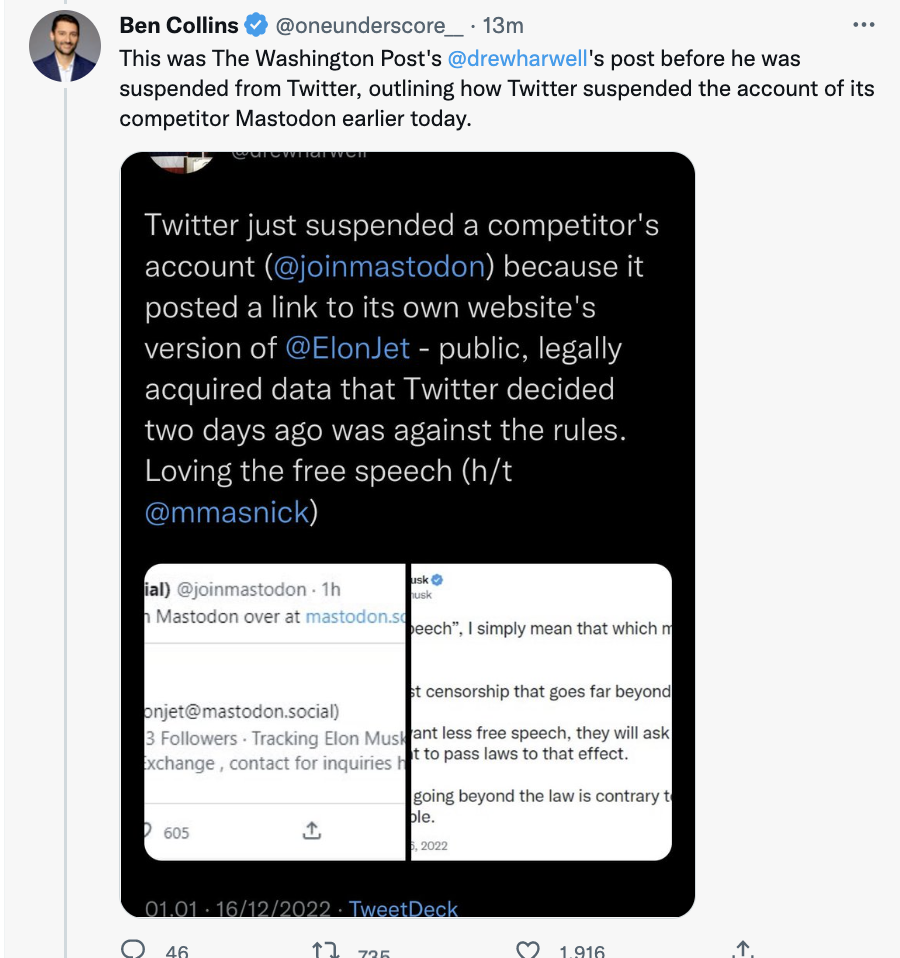On Thursday evening, Twitter suspended a number of prominent journalists on the platform without warning or explanation.
The situation followed the company’s decision to suspend the Twitter account of Mastodon, an open source social media alternative that’s built momentum since Elon Musk took over at the company. Twitter took action against Mastodon after the account linked to the Mastodon page of @ElonJet, a student-made bot that tracks the whereabouts of Musk’s private jet.
At least some of the accounts suspended had shared screenshots and observations about Mastodon’s suspension. Just prior to his suspension, Washington Post reporter Drew Harwell tweeted about Mastodon being kicked off the platform.

Twitter/Ben Collins
Former MSNBC host Keith Olbermann, The New York Times’ Ryan Mac, CNN’s Donie O’Sullivan, Mashable’s Matt Binder, and journalist Aaron Rupar were also suspended Thursday evening. Many of the reporters regularly covered Musk’s takeover of Twitter in recent months.
Rupar weighed in on his suspension on Substack, observing that while he did not know why his account was deactivated, he did share a link to the ElonJet Facebook account in the course of reporting on the subject. Through an alternate account, Mac shared the message he received from Twitter and noted that there was no warning before the permanent suspension.
While we don’t know what’s going on here yet, it’s possible that the suspensions are the result of automated content moderation gone awry. Some of the suspended accounts shared Mastodon and ElonJet’s Twitter handles as well as images of the tweet that appears to have gotten the former account suspended.
In light of Twitter’s reduced human moderation teams, it’s possible that automated systems enforcing Twitter’s brand new rules against accounts like @ElonJet were overzealous in this instance. But it’s at least as likely that this is a case of Musk directing the moderation process based on his own preferences — we just won’t know until someone at Twitter explains what’s going on.
Update: Musk just weighed in on the suspensions, characterizing them as intentional. “Same doxxing rules apply to “journalists” as to everyone else,” he tweeted in a reply.
TechCrunch has reached out to Twitter’s new head of trust and safety Ella Irwin for an explanation of why the accounts were not given the opportunity to delete the offending tweets, which is standard practice for many Twitter infractions. It’s worth noting that the policy these accounts violated, a prohibition against sharing “live location information,” is only 24 hours old.
This story is developing…
Twitter just banned prominent journalists who cover Elon Musk with no explanation by Taylor Hatmaker originally published on TechCrunch
source https://techcrunch.com/2022/12/15/twitter-just-banned-a-wave-of-prominent-journalists-with-no-explanation/
Comments
Post a Comment